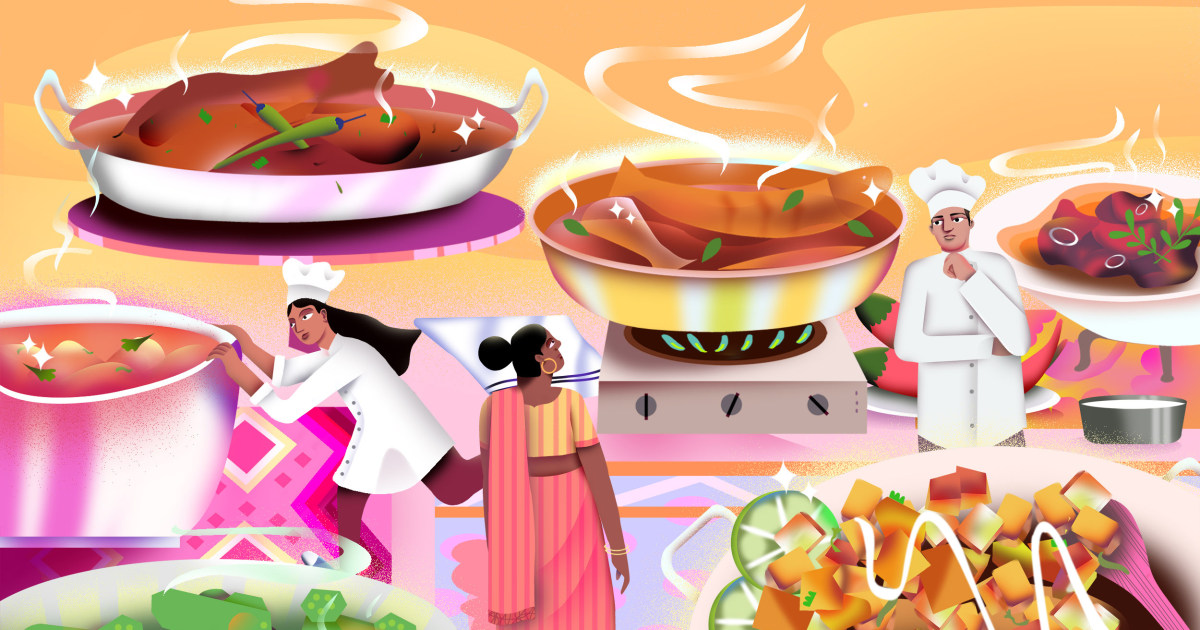
The Hindi expression “ghar ka khana” translates, quite simply, to “home food,” and it carries with it a certain sentimentality. It’s the crackling and pop of jeera hitting the pan. It’s the jarring whistle of the pressure cooker as dal softens on the stove. And the slightly sweet smell of just-done basmati rice has a universal meaning: It’s time to sit down for a meal.
Desi American families hold their recipes close; they’re a tangible reminder of home and the generations it took to perfect them. But a step outside into the food landscape of the white west often reveals a culture that disregards, oversimplifies and stereotypes their meals.
“‘Your food must be really spicy. It must be stinky. It’s curry,’” Instagram food blogger Nisha Vedi Pawar, 36, told NBC Asian America. “And I was like, ‘What the hell is curry?’”
Desi chefs and home cooks grew up watching their parents make chawals, sambars, subzis and bajjis, an array of dry and gravied dishes from all over South Asia. But the British colonial word “curry” erased the distinction between them. “Curry” has long been used by white people to lump all dishes with stew or gravy into one category. But it’s a made-up word, and some brown cooks say it’s time for it to go. Or at least to be scrapped as a catch-all term for food from the Indian subcontinent.
“Curry shouldn’t be all that you think about when you think about South Asian food,” said Chaheti Bansal, 27, who posts her home-cooking videos online. In June, Bansal posted a recipe where she called on people to “cancel the word ‘curry.’” It’s since amassed over 3.6 million views after being reposted by BuzzFeed’s Tasty. She told NBC Asian America it’s not about fully canceling the word, just ending its use by people who don’t know what it means.
South Asian American cooks say they’ve spent their lives untangling shame and misconceptions when it comes to their foods, and now, they just want to celebrate it.
“Food is our backbone,” Pawar said. So it only makes sense for the conversations about “curry” to start where the food is: at home.
“Curry” isn’t an actual South Asian word
As South Asians across the diaspora know too well, generations of white people have misunderstood their cuisines. The way Desi food was characterized by the British during occupation has given way to the modern dismissal of thousands of distinct dishes as smelly, messy and unrefined, said Ilyse R. Morgenstein Fuerst, an associate professor of religious studies at the University of Vermont whose work focuses on South Asia.
When it comes to “curry,” there are several theories.
“The word curry does not exist in any South Asian language to my knowledge,” said Morgenstein Fuerst. “Curry is one of these words that most historians attribute to the British bad ear.”
There are a few different schools of thought about which word British colonizers got “curry” from, Morgenstein Fuerst said. The most popular suggests that the British misheard the Tamil word “kari,” which itself means different things from region to region, ranging from “blackened” to “side dish.”
British officers in India adopted the word and spread it throughout the region as a loose description for pretty much any food they encountered, Morgenstein Fuerst said. It was a way for the British to avoid learning the names of extremely specific regional dishes and lump them all into one category — spicy, fragrant curry.
Europe has a long history of coveting South Asia for its spices, starting as early as the 1400s.
“There’s a long history of imagining what we would call Indian food as exotic and sought after,” she said. But despite white cravings for South Asian food, there was an expectation that cooks would appeal to the European palate. They wanted food that was spiced, Morgenstein Fuerst said, but not too much. Fragrant, but not smelly.
“And that lack of temperance, in our food, or in our emotionality, is a problem,” she said. “That’s one of the things that is rooted in white, Christian supremacy.”
So when the British came in the 1850s and started calling everything “curry,” Morgenstein Fuerst said, it was shifting power systems that made South Asians start using the word, too.
“South Asians can turn around and say, ‘OK, if these British officers want curry, and I stand to profit, whether that’s socially, politically, financially, then I set up a curry house,’” she said.
Colloquialisms are hard to undo, she said, so the word “curry” remains in the names of specific dishes. It’s used often in South India, sometimes to describe dishes in a gravy, dishes with meat, dishes with vegetables or side dishes, depending on the region.
Food as a form of collectivism
Dismissal and stereotyping make dinners at home all the more sacred, Desi Americans say. Home cooks note that their love for food came by being immersed in it constantly at home, and watching their parents and grandparents feed their communities showed them a lifestyle beyond U.S. individualism. Cooking doesn’t just mean eating, it means taking care of the people around you.
Growing up in Florida, Pawar’s family was one of the only brown ones in town. There was only one Indian store, and even with it, lots of ingredients her mom needed weren’t available.
But the family still never saw food as a task, Pawar said. “It’s always been such a joyous occasion. It’s always been something with immense love.”
Her mom would cook for the family even when she was tired. A toor dal with chilke wale aloo (lentils with potatoes) was one of the most common after-work dinners. She takes issue with the way people see Indian food as always being in a fatty, buttery tomato sauce.
“It’s just like for American food. You wouldn’t want everything dipped in like Old Bay right?” Pawar joked. “You wouldn’t want to put everything with good old American French’s mustard. The same way, we don’t put everything in tikka sauce.”
For Bansal, lunchroom teasing through middle and high school about her “smelly” food made her wary of bringing fragrant lunches to the cafeteria, even though she loved her mom’s cooking. She begged her parents to buy Lunchables or to let her make her own sandwich.
“I stopped bringing Indian food, but then secretly I would have three servings at home for dinner,” she said.
It wasn’t until she moved to California, with her parents in New York, that she realized how much she longed for those familiar smells. So she called her mom and started to learn all the familiar dishes, like bhindi masala (spiced okra), aloo patta gobhi (cabbage, potato and cauliflower) and dal tadka (dal with spices mixed in). Even from afar, food made her feel closer to those she loved, and posting her recipes allowed her to expand her circle of South Asian friends even further.
Collectivism took a human form in Pawar’s grandmother, she says. She remembers summers in London when her dadima seemed to be feeding everyone constantly.
“She had this open door policy,” she said. “I don’t think I’ve really ever seen that anywhere else. I feel like it’s almost a thing of a gone generation. I don’t know how but this woman always would make enough food. She would always have enough to give to people.”
The two would sit in the kitchen making rotis and pani puri en masse to make sure everyone filtering in and out had their fill. For Pawar, it’s the people she associates with food that build her love for it. Her mom, her grandmother and now, her 8-year-old daughter.
Use “curry,” but don’t abuse it
With their online food videos and social media influence, Pawar and Bansal feel they’ve been chipping away at some of the assumptions and oversimplifications that exist in the Indian food arena. Overuse of “curry” is certainly one of them, but it’s the tip of the iceberg, they say.
“You can travel like 100 kilometers, and you can get a completely different type of cuisine,” Bansal said. “And it’s a completely different language and a different culture. And it just goes to show that there’s so much diversity in our food that doesn’t get recognized.”
They know that language doesn’t change overnight, and there are power systems in place that keep even some South Asian cooks from expanding beyond butter chicken and naan. But they encourage people to be intentional with their wording, learn about what they’re eating and recognize that “Indian food” is an umbrella term that contains hundreds of completely distinct cultures and cuisines.
And no, the word “curry” is not completely canceled, Bansal said. Sometimes, it’s even correct.
“My partner is Sri Lankan, I have friends that are Malayali, friends that are Tamil, and yes they use the word curry,” she said. “I enjoy their curry. Even their curry names have very specific traditional names paired with it, or it’s referring to something very specific. But you shouldn’t just lump all of our foods together under this term.”
The burden of constant explanation can be exhausting, Desi cooks say. They don’t want to have to defend their cultures and cuisines with every Instagram post, and they don’t always feel like they’re in a position to educate the masses. Instead, they simply want to cook, enjoy their food and share it with whoever will listen.
“It’s part of me,” Pawar said.
Source: | This article originally belongs to Nbcnews.com










